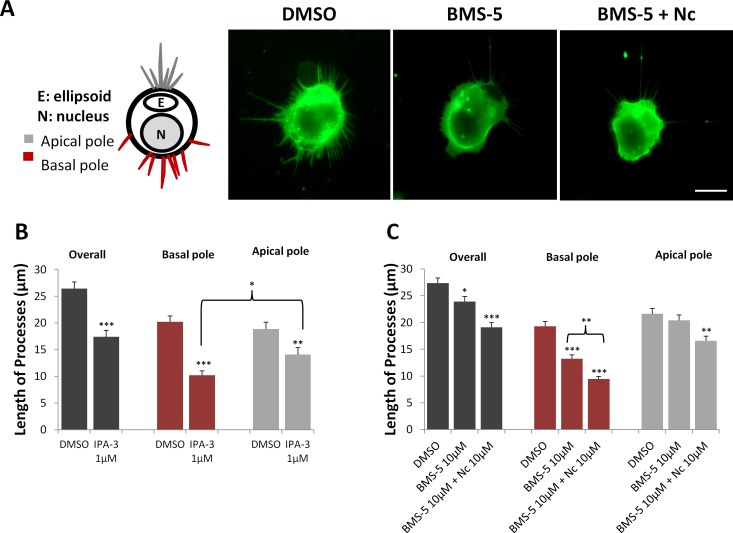Figure 8.
Growth of processes by rod cells is reduced with Pak or LIMK inhibition; blockage of Ca2+ influx furthers the effect of LIMK inhibition. (A) Left: Cartoon of regional designations for rod cell processes. In the intact retina, axonal processes grow from the basal/nuclear pole, whereas calycal processes that surround the outer segment grow from the apical/ellipsoidal pole. Right: Representative rod cells with rod opsin labeling from DMSO control, 10 μM BMS-5-, and 10 μM Nc plus 10 μM BMS-5-treated cultures after 3 days. Cells in control, untreated cultures show the most growth. Scale bar: 10 μm. (B) Length of the longest process from three regions (overall, longest process regardless of region of origin; basal, from the cell surface close to the nucleus; apical, from the cell surface close to the ellipsoid) of each rod cell. Pak inhibition with 1 μM IPA-3 reduced process growth of rod cells after 3 days in culture from all regions, compared to control. In control cells, length of apical and basal processes is similar; in IPA-3-treated group, basal processes shortened significantly more than apical processes. n = 3 animals, 12 cultures, 360 rod cells, ∼180 cells per group; *P < 0.05, **P < 0.005. (C) LIM kinase inhibition with 10 μM BMS-5 reduced process growth overall and from the basal but not the apical pole. Blockage of Ca2+ influx increased the effect of LIMK inhibition and reduced process growth from basal and apical regions. n = 3 animals, 18 cultures, 540 rod cells, ∼180 cells per group; *P < 0.05, **P < 0.01, ***P < 0.001; (B) Student's t-test; (C) 1-way ANOVA.

